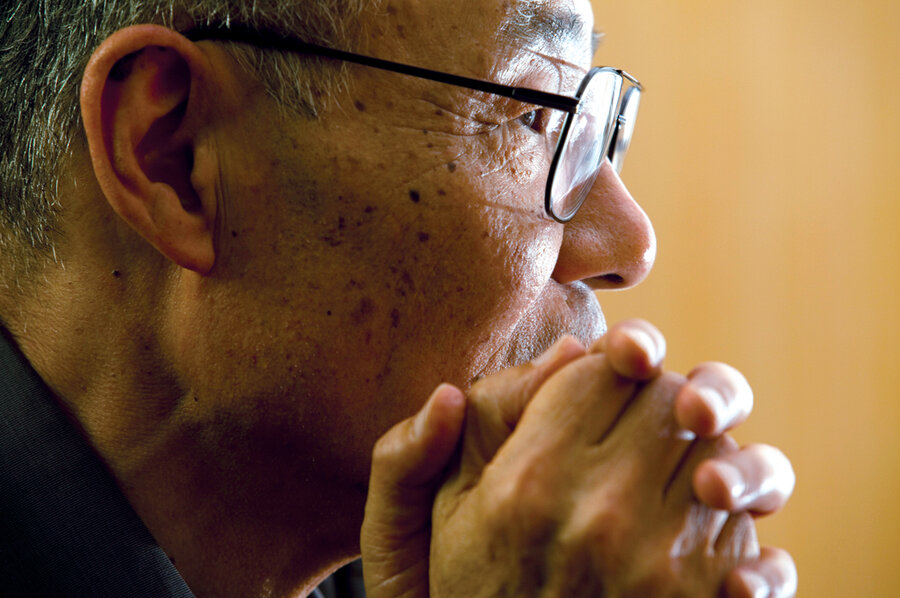Fukushima's nuclear cauldron: Retirees who want to go in
Loading...
| Tokyo
Nothing makes Nobuhiro Shiotani angrier than to be called a "kamikaze."
Certainly, the sober and precisely spoken retired scientist does not look like a World War II suicide pilot. And he is insistent that his plan to lead 300 elderly pensioners in a bid to stabilize the crippled Fukushima Daiichi nuclear power plant is motivated not by some mad death wish but by pure rationality.
"Older people taking the risk is much less damaging to our society than asking the younger generation following us to take it," Dr. Shiotani says, adding bluntly, because we are nearer the end of our lives anyway.
Shiotani and an old friend, former plant engineer Yasuteru Yamada, founded the Skilled Veterans Corps (SVC) in April, less than a month after a tsunami overwhelmed the cooling system at Fukushima, causing the world's worst nuclear accident since Chernobyl.
By writing letters and e-mails, using Twitter, and sending out a call to action at various blogs, the two men have drawn more than 300 retired engineers and scientists, ranging in age from 60 to 78, into their group. All are offering to use their skills and experience to help cool the reactors following the partial meltdown at the heavily contaminated site. "To my surprise we've received quite a large number of favorable responses," says Shiotani. "They all say they think it's their duty not to leave this negative heritage to younger generations."
Seven members of the veterans group worked at Fukushima during their active careers, he adds. "They feel like mothers who have lost their children."
With their backgrounds as nuclear plant designers, electrical engineers, radiation regulators, and physicists, the retirees "could if they wish get a decent job at Fukushima, but they have chosen us," says Shiotani. "They want to work not for money, but for something fundamental and essential for society."
Called to action
Shiotani himself, a materials engineer, says he feels motivated to volunteer at Fukushima by a personal sense of responsibility.
The plant, he says, "is a grandchild of science. The crisis was caused by human error, and the mess created by scientists and engineers should be cleared up by scientists and engineers themselves. As a physicist I feel it is indirectly partly my fault."
So far the Japanese government and the plant's operator, Tepco, have responded hesitantly to the SVC's proposal.
"The government has said it will welcome our help, but that could be just lip service," says Shiotani. "But they have not rejected us flatly."
Tepco "is quite reluctant to accept us because they are quite proud," he adds. "They want to be able to say they can contain the accident themselves."
But the group's organizers say they detect some movement in official attitudes. The first time he met Tepco executives, "they just pretended to be surprised by our proposal," Shiotani recalls. "Probably to them we are crazy guys."
At a second meeting with officials from both Tepco and the government, however, "my impression was that they were softening," says Shiotani. "Reluctantly they started to consider us."
Some 3,000 people are working at the Fukushima site at the moment, but most of them are unskilled laborers, and all have to be regularly relieved in order to avoid excessive exposure to radiation. Several are reported to have absorbed more than the legal limit already. And about 9,000 workers have been involved in the four-month operation to stabilize the plant.
A handful of SVC members plan to visit Fukushima Daiichi for the first time soon, according to Shiotani. But bravery has its practical aspects, and he is still bogged down in the prosaic problems of insurance.
Appeal to expand insurance coverage
"We are very conscious about our safety … and we have no intention to send our members to Fukushima without insurance," Shiotani says firmly. "I think that's quite reasonable."
The problem is that Japanese state-run insurance plans do not cover volunteers, and private plans do not cover radiation risks. "We are asking government officials and lawmakers to make some sort of government-supported insurance for volunteers," explains Shiotani. "But I have no confidence how soon they can act."
Tepco's recent reports of a second day of deadly radiation levels might not help matters.
In the meantime, Shiotani and his colleagues are working with younger volunteers on fundraising and meeting members of parliament in a bid to win political support for their project.
One thing they are not doing, he says, is arguing over the merits of nuclear power.
"I just hate disputes amongst us, and it has nothing to do with repairing the reactors," he says. "We will have plenty of time after we have brought the reactors to a stable state to debate and argue.
"I've enjoyed the benefits of the Fukushima plant for such a long time, why not thank them by providing some help?" he adds. "Criticizing is very easy, but it's not so easy to make things better. That's why we are sweating so much."





